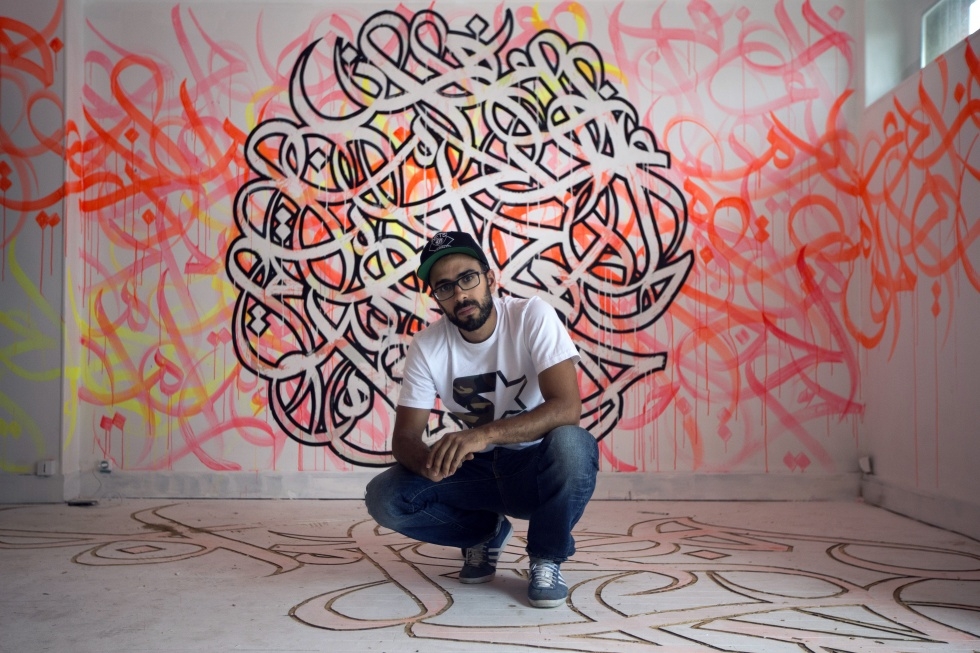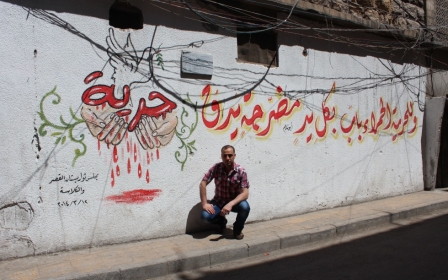Tunisian eL Seed’s mural affair

With work adorning the walls of global cities such as Melbourne, London and Toronto, and even an urban expressway in Doha boasting 52 of his intricate murals, the sprawling art of eL Seed simply cannot be confined to a gallery space. EL Seed uses a unique artistic vision that is called Arabic calligraffiti, combining the freestyle technique of street art with traditional Arabic calligraphy.
Born to a Tunisian family in France, he first experienced his art in the streets of Paris, tagging his name on walls. It was only in his teens that he discovered an interest in his Tunisian roots. He began as a graffiti artist in 1998 and started using the Arabic script on walls around 2004. Back in 1998, the artist told MEE: “I was into hip-hop with breakdancing, and I had a strong passion for the Arabic old tradition of calligraphy.”
He attended business school and never had any formal training in the arts; it was only during his time in North America, after meeting French street artist Hest1 (he doesn’t paint in the Arabic script but his letters are arabesque), that he became really engaged - combining his love for graffiti with his love for calligraphy.
Eventually, eL Seed started developing his own artistic philosophy. “I perceive my calligraffiti as a tangible expression of my search for identity, both as an individual and as an artist,” he explained. “My compositions, that combine the freestyle technique of street art with traditional Arabic calligraphy, reflect the tension represented in my hyphenated identity. Despite being born and raised in France, I am not considered French. Actually, I perceive myself with strong north African roots, which I want to keep alive.”
Today eL Seed no longer tags his name – using instead the metaphor of a plant. He has a large portfolio of work that he has acquired through an inspiring journey. His art adorns walls across every continent, from Paris to Montréal, Berlin, Tunis, Doha, Dubai, Chicago, Los Angeles. And in September, he was invited to paint the walls of Rio de Janeiro. This is a huge honour, as Brazilian graffiti art is considered to be among the most significant strands of the global urban art movement.
Seductive style
The aesthetic and style of each of eL Seed’s works can be as influential as the message itself. He engages in a study of sinuous letters sprayed in pastel and bright colours (Montana 94 is his favourite brand of spray paint), so that the emotion is born within the viewers even before they discover the meaning of his calligraphy. His style seduced the French luxury brand, Louis Vuitton, who asked him to contribute to its Foulards d’Artistes project and than to customise the brand’s iconic monogram trunk. His unique style has also been appreciated by Jack Lang, the president of the Institute du Monde Arabe (IMA), in Paris, who recently invested in Arabic calligraffiti’s potential to create social cohesion. He invited eL Seed to decorate a section of IMA with elegant letters in blue and silver colors. The area he covered was 800 square metres. The work was inspired by a quote from the French writer Stendhal, saying: “Love is the miracle of civilisations” translated into Arabic.
Sorting out Arabic calligraphy from the box of traditionalism was not an easy task. The concept, eL Seed explained, existed before he embarked on his own calligraffiti. For example, artist Niels Meulman started calligraffiti in the late 1990s early 2000s (in the 1980s he was one of the most influential graffiti writers in Europe), dabbling with traditional European calligraphy – the script of medieval manuscripts –with modern graffiti art. While in 1984, Jeffrey Deitch curated his first Calligraffiti exhibition in Los Angeles, where New York Wild Style graffiti artists were paired with contemporary artists from the Arab world, working in the calligraphy tradition, in an attempt to explore their interests in fusing language with abstract forms. Perhaps it is no surprise that 30 years later Jeffrey Deitch wrote the introduction to eL Seed’s book, Lost Walls: A Calligraffiti Journey Through Tunisia, which was published in 2014.
During the past three years, eL Seed’s personal (and artistic) journey took him back to Tunisia several times. After the Arab Spring, his desire was amplified. One of his most extraordinary calligraffiti works is on the minaret of Jara Mosque, in Gabes, his ancestral home.
“In May 2012, an art fair in Tunisia was the backdrop of violent clashes between religious groups and seculars,” he wrote in Lost Walls. “This event sparked numerous debates concerning freedom of expression and the place of the artist in Tunisian society.” Two months later eL Seed delivered a message of reconciliation and respect, painting a message from the holy Quran on to the Jara Mosque.
“The message had to be universal, one that would speak to all mankind and would encourage acceptance,” he said in his book. The verse he chose to paint was: “O mankind, we have created you from male and female, and have made you into people and tribes so that you may know each other.” The book Lost Walls actually recounts another journey that he took a year later. It chronicles the painting of 24 “lost” walls in four weeks in a road trip around Tunisia. Incidentally, eL Seed also painted on the set of Star Wars. It is interesting to note that some Star Wars fans actually criticised eL Seed for this, as did some Tunisians who behaved as if the Hollywood set was actually a Tunisian heritage site.
Popular trend
In August 2014, eL Seed went back to Tunisia one more time - he is not the only Arab artist doing calligraffiti or general street art. Up until 2010, there was only a handful of artists practising this style, most of them unknown to each other. After the Arab Spring - and some press - calligraffiti has become increasingly popular. Artists Zepha aka Vincent Abadie Hafez (France) and Yazan Halwani (Lebanon) also have a unique approach to calligraffiti and street art. No wonder: calligraphy is actually a free-form style of urban art that frequently occurs in the urban and suburban surroundings of Arab cities. This summer eL Seed joined the street art project Djerbahood, an event that involved 150 artists from 30 countries to paint the streets and walls of Erriadh, a village in Djerba. It was curated by Mehdi Ben Cheikh of the French gallery Itinerrance (Paris), and cemented eL Seed’s place on the global street art stage.
Middle East Eye propose une couverture et une analyse indépendantes et incomparables du Moyen-Orient, de l’Afrique du Nord et d’autres régions du monde. Pour en savoir plus sur la reprise de ce contenu et les frais qui s’appliquent, veuillez remplir ce formulaire [en anglais]. Pour en savoir plus sur MEE, cliquez ici [en anglais].




